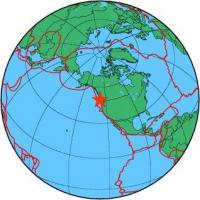The island of Vancouver, Canada, on the lithospheric plate of Juan de Fuca, August 4, 2013 an earthquake of magnitude 5.7 at a depth of about 2 km.

Triggering of T-Square Moon, Jupiter-Uranus-Pluto-cosmological line-seismic response.
These EMSC-European-Mediterranean Seismological Centre.
| Magnitude | mb 5.7 | | Region | VANCOUVER ISLAND, CANADA REGION | | Date time | 2013-08-04 13:22:28.0 UTC | | Location | 49.81 N; 127.14 W | | Depth | 2 km | | Distances | 3821 km NW of Ottawa, Canada / pop: 812,129 / local time: 09:22:28.0 2013-08-04
314 km NW of Victoria, Canada / pop: 289,625 / local time: 06:22:28.0 2013-08-04
115 km NW of Tofino, Canada / pop: 1,655 / local time: 06:22:28.0 2013-08-04 |

For the region is projected gravitational wave Uranus.
Earthquake off Vancouver Island August 4, 2013 occurred in the area of the cosmological 27 earthquake prediction in August of 2013.
In the forecast of the dates of the resonance of seismic activity in the area of 27 - probability - 65 - 85% - 4, 6-7, 13, 17, 19, 23-24, 26-27, 31.08.2013.
Triggering of T-square Moon, Jupiter-Uranus-Pluto. Seismic response.
Still
a possibility of resonant earthquakes in the region and adjacent areas
of seismic activity - in the area of New Moon, August 7, 2013.
For
a more accurate prediction of seismic events, cooperation cosmology
kosmoritmologii with seismic, volcanic monitoring services, accounting
pre-shock foreshocks in seismically active regions.
Only
the combination of cosmological and seismic factors, the actual seismic
data of resonance in, rattling seysmozone-able to give an accurate
prediction of earthquakes within one day.
Cosmology allows you to specify the dates of earthquakes and volcanic eruptions in seismically active regions, up to one day.
The
next date of increase of seismic activity, volcanic activity on the
resonance of tectonic faults in subduction zones, active seysmozone:
Reversal of Proserpine in direct motion-July 29, 2013 - seismic response + - 14 days.
New Moon-August 7, 2013 - seismic response + - 3 days.
Active Space-axis Dubhe-Alnair-cosmological factor seismic.
Ingression of Mercury in the sign of Leo, August 8, 2013 - seismic response + - 3 days.
Ingression of Venus in the sign of Libra, August 16, 2013 - seismic response + - 3 days.
Research
links seismic activity, volcanic activity, intensive demonstration of
the Elements with Space factors, the gravitational fields of the
planets, the solar activity, torsion fields and beams of near and far
space-Fixed Stars, Nebulae, Galaxies, conducted in the method of "Cosmology, Astrology as a security system" . Software-astroprocessor ZET GEO.
Andrey Andreev-kosmoritmolog.
Cosmology, Astrology as security-Praemonitus praemunitus-forewarned is forearmed.
Seismically active regions of the globe .
Help.
Lithospheric plate Juan de Fuca
(named after the explorer Juan de Fuca, a Greek by birth, who served as
Spain) - tectonic plate, rising from an underwater ridge of Juan de
Fuca and the "diving" under the northern part of the western edge of the
North American plate.
Juan de Fuca plate in the south of the fault zone is bounded Blanco
(born Blanco Fracture Zone), in the north - Nootka fault (English Nootka
Fault), and throughout the western side - the Pacific oceanic plate.
Initially, the Juan de Fuca plate was part of the once vast Farallon
Plate (born Farallon Plate), a past deep under the North American plate
and is divided into three parts.
The name plate is used in some cases for the entire underwater area
spreading (from Fr. Vancouver in the north to northern California to the
south), in other cases - only the central part of the zone spreading.
After distinguishing the names of the plates of Juan de Fuca, the
southern part was called Gorda plate (born Gorda Plate), while the
northern - Researchers plate (born Explorer plate).
As a result of immersion Juan de Fuca plate under the North American
plate in the western U.S. have volcanic Cascade Mountains, which stretch
along the west coast of North America from the southern border of the
Canadian province of British Columbia to the northern part of the U.S.
state of California, and are part of the volcanic Pacific Ring of Fire. The last major earthquake in the Juan de Fuca plate was 8,7-9,2 magnitude on the Richter scale. According to the Japanese registration data, the Cascadia earthquake happened the evening of Tuesday, January 26, 1700.
Then a huge wave wiped out coastal towns and villages at the mouth of
the Columbia River, and the echoes of the disaster sunk right up to the
coast of Japan.
As a result of the earthquake on the surface of the Juan de Fuca plate
formed a fault length of about 1,000 kilometers and an average width of
20 meters.
|
 Main
Main 
 Registration
Registration Login
Login